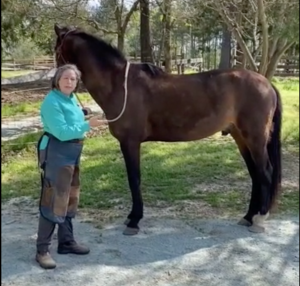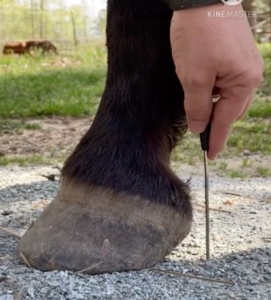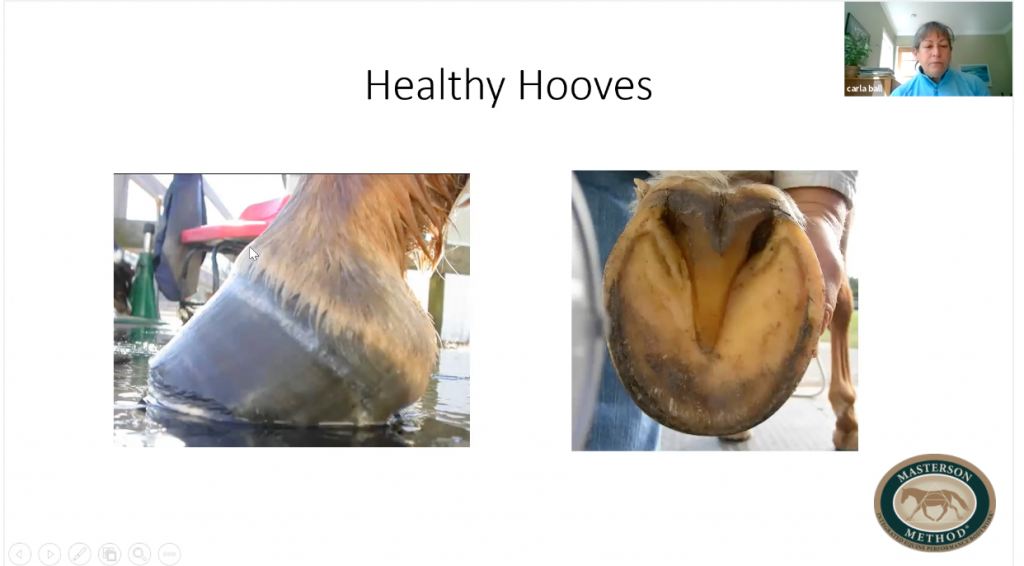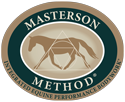by MMCP, Carla Ball
Many Masterson Method Certified Practitioners (MMCP) are also experts in other fields of horse care. Twelve MMCP’s are featured in the Hands Online Expert Hour Topics library of videos (see the Masterson Method Store ) where they share their particular expertise as it relates to The Masterson Method bodywork.
From December 2020 through November 2021, we hosted the Hands Online Membership to help bring the community together in an online learning environment. Jim offered two live monthly calls, and practitioners offered a third call. For some of these Expert Hour Topics, the MMCP prepared a presentation video that members previewed in advance of the live question and answer Zoom call.
 For this blog we highlight one such Expert Hour Topic featuring Carla Ball, a MMCP and a Barefoot Trimmer. To introduce the topic of hoof balance and how she considers the whole horse when trimming, Carla filmed her own assessment and barefoot trim on Bellus, a really sweet 15-year old Lusitano horse. Here is an adapted excerpt from Carla’s introductory video:
For this blog we highlight one such Expert Hour Topic featuring Carla Ball, a MMCP and a Barefoot Trimmer. To introduce the topic of hoof balance and how she considers the whole horse when trimming, Carla filmed her own assessment and barefoot trim on Bellus, a really sweet 15-year old Lusitano horse. Here is an adapted excerpt from Carla’s introductory video:
“When looking at a horse for the first time, one of the things I want to assess in the horse is how they are standing and if they can square up (…not every horse can). What does it look like when he’s standing in what seems to be “comfort” for him. I want to look from the front and see if his stance is base-narrow, wide, or pretty much underneath him? From a bodyworker perspective, I’m interested in the space in this chest and whether that seems tight or relaxed.
Also, from a static perspective I’m going to look at him from the side and in this case, Bellus is standing with his front feet directly underneath him which is what I hope to see in any situation. If they stand with their front feet parked in front of them or behind on a pretty regular basis, that tells me that there’s most likely discomfort somewhere in the feet that also may be a reflection of something going on in the body.
When I ask them to walk forward, how are their feet tracking? Are they tracking underneath themselves? Are the feet placed out laterally or too wide apart? Are they crossing over to the midline? Too wide or too narrow would imply either an imbalance in the feet specifically and/or and imbalance in the body. Also, when when I watch a horse walk I’m looking at the footfalls and length of stride.
Lastly, as I watch a horse walk or trot from behind, I’m looking for a couple of things: how does the tail hang from their body? As they walk, does the tail stay in the midline or does it shift to one side more than the another? I’m also looking to see if the hips drop equal from one side to the other, because if they’re not, then there may be something going on in the hip or pelvis that we would need to consider.
I’m also looking for a few things in each foot itself. I want to see how the walls diverge from the hairline. From the front I look right at the center of the hairline. If this line looks straight just in the center, that would imply the horse most likely has a balanced hoof.
 I also look at the hoof from the side. One thing that’s going to be important is the height and length of the heel. The height of the heel (the distance between the heel hairline from the side view and the ground, if you draw a plum line vertically) on an average horse should be about three centimeters (a little over one inch). I want the weight of the foot to be as far back as possible. The horse will be able to stand more comfortably if he has a longer base to stand on to bear weight.
I also look at the hoof from the side. One thing that’s going to be important is the height and length of the heel. The height of the heel (the distance between the heel hairline from the side view and the ground, if you draw a plum line vertically) on an average horse should be about three centimeters (a little over one inch). I want the weight of the foot to be as far back as possible. The horse will be able to stand more comfortably if he has a longer base to stand on to bear weight.
Looking from the side of the hoof, the angle of the coronet or hairline from the front of the hoof to the heel would ideally be about 30 degrees.”
During the question and answer session, Carla answered questions regarding the following considerations:
- Feet and the horses body.
- What is compensation?
- Exercise: becoming mindful of the effects of small changes on the body.
- Healthy hooves.
- Trimming: The importance of trimming, even if the horse has shoes, to maintain a balanced hoof.
- Bone Column: if the hoof is imbalanced, the bones will be imbalanced and the musculature will be imbalanced. Everything affects everything.
- Posture: Be attentive to the horses stance. If you see a horse standing with his feet anywhere other than squarely under their body, there will be compensation. Look at the horse from all directions while they are standing to check for stance. Watch the horse moving. Compare length of stride, watch and listen to footfall. Walk beside the horse and match their leg movement which allows you to ‘feel’ their footfall.

We enjoyed Carla’s introduction to hoof balance and bodywork and think you’ll find this and the other 11 Expert Hour Topics a fascinating addition to your resource library. When you purchase the Hands Online Library Expert Hour series, you can take a deep dive into this and other important areas of horse care and study.
